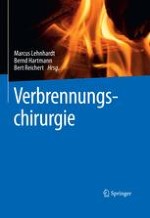2016 | OriginalPaper | Buchkapitel
6. Pathophysiologie der Verbrennungskrankheit
verfasst von : Dr. med. Richard M. Fakin, Dr. med. Merlin Guggenheim, Dr. med. Christoph Wallner, Univ. Prof. Dr. med. Marcus Lehnhardt, Prof. Dr. med. Pietro Giovanoli
Erschienen in: Verbrennungschirurgie
Verlag: Springer Berlin Heidelberg











